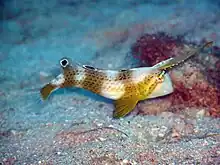| Iniistius pavo | |
|---|---|
 | |
| Scientific classification | |
| Domain: | Eukaryota |
| Kingdom: | Animalia |
| Phylum: | Chordata |
| Class: | Actinopterygii |
| Order: | Labriformes |
| Family: | Labridae |
| Genus: | Iniistius |
| Species: | I. pavo |
| Binomial name | |
| Iniistius pavo (Valenciennes, 1840) | |
| Synonyms[2] | |
| |
Iniistius pavo, the peacock wrasse or blue razorfish, is a species of marine ray-finned fish from the family Labridae, the wrasses, which has a wide Indo-Pacific distribution.
Description
Iniistius pavo can be identified by the dark vertical bar situated below the eye.[2] This species has a small dark spot below the forward portion of the dorsal fin, a white patch behind the side behind the pectoral fin, and an oblique brown bar underneath the eye.[3] It normally shows 5 dark bars when adult when the belly of female turns red. Juveniles have a black anal fin and two large eyespots which have narrow white margins in their dorsal fin. The first two spines in the dorsal fin form a separate fin. [2] It has a highly compressed body and a steep, sharp-edged forehead, like other members of the genus Iniistius.[3] In juveniles this separate fin formed by the first two spines takes the form of a long, bannerlike filament but as the fish ages this shortens. The colour of the juveniles varies from whitish with dark bars on the body, to an overall brown colour. The small juveniles drift in the water mimicking leaves and debris.[3] This fish may attain a total length of 42 centimetres (17 in).[2]
Distribution
Iniistius pavo has an Indo-Pacific distribution which extends from the Red Sea and the east African coast as far south as KwaZulu-Natal eastwards to the Society Islands, north to southern Japan and Hawaii and south to New Caledonia, Lord Howe Island and New South Wales.. It also occurs in the Eastern Pacific from the Gulf of California to Panama and the Galapagos Islands.[1]
Habitat and biology
Iniistius pavo is normally found as a solitary, benthic and benthopelagic species in lagoon and seaward reef areas where the substrate consists of fine to loose, coarse sand. The juveniles are sometimes recorded in shallow estuaries. The adults are rare in water which is less than 20 metres (66 ft). The species dives into the sand to sleep securely at night and also will go this to hide when threatened, using the sharp edge to the snout to speedily bury itself.. It feeds on hard-shelled invertebrates, such as molluscs and crustaceans. The juveniles use the elongated, detached front portion of their dorsal fin to impersonate drifting dead leaves.[2][1]
Species description and taxonomy
Iniistius pavo was formally described as Xyrichtys pavo in 1840 with the type locality given as Mauritius.[4] When Theodore Nicholas Gill erected the genus Iniistius he named this species as the type species.[5]
Human usage
Iniistius pavo is not a commercially exploited quarry species, its flesh is said to be highly palatable[2] and when large enough fish are caught they may be marketed. It is occasionally collected for the aquarium trade.[1]
References
- 1 2 3 4 Russell, B. (2010). "Iniistius pavo". IUCN Red List of Threatened Species. 2010: e.T187705A8606763. doi:10.2305/IUCN.UK.2010-4.RLTS.T187705A8606763.en. Retrieved 20 November 2021.
- 1 2 3 4 5 6 Froese, Rainer; Pauly, Daniel (eds.) (2019). "Iniistius pavo" in FishBase. August 2019 version.
- 1 2 3 Bray, D.J. (2017). "Iniistius pavo". Fishes of Australia. Museums Victoria. Retrieved 13 January 2020.
- ↑ Eschmeyer, William N.; Fricke, Ron & van der Laan, Richard (eds.). "Xyrichtys pavo". Catalog of Fishes. California Academy of Sciences. Retrieved 12 January 2020.
- ↑ Eschmeyer, William N.; Fricke, Ron & van der Laan, Richard (eds.). "Iniistius". Catalog of Fishes. California Academy of Sciences. Retrieved 12 January 2020.
External links
- http://www.fishbase.org/summary/5613
- Photos of Iniistius pavo on Sealife Collection
